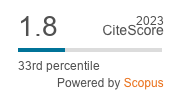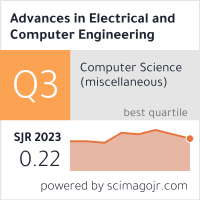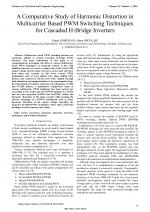| 3/2016 - 3 |
A Comparative Study of Harmonic Distortion in Multicarrier Based PWM Switching Techniques for Cascaded H-Bridge InvertersHAMEDANI, P. |
| View the paper record and citations in |
| Click to see author's profile in |
| Download PDF |
Author keywords
converters, harmonic distortion, inverters, modulation, pulse width modulation
References keywords
electronics(16), power(13), multilevel(12), transaction(10), industrial(9), inverter(8), inverters(7), modulation(6), cascaded(6), voltage(5)
Blue keywords are present in both the references section and the paper title.
About this article
Date of Publication: 2016-08-31
Volume 16, Issue 3, Year 2016, On page(s): 15 - 24
ISSN: 1582-7445, e-ISSN: 1844-7600
Digital Object Identifier: 10.4316/AECE.2016.03003
Web of Science Accession Number: 000384750000003
SCOPUS ID: 84991109323
Abstract
Multicarrier based PWM switching patterns are commonly utilized to control Cascaded H-bridge (CHB) inverters. The main contribution of this paper is to comprehensively investigate the effect of various multicarrier based PWM techniques on harmonic content of the CHB multilevel inverter. In order to achieve this, both of the CHB output voltage and the input current at power grid side have been taken into account. In this work, various PWM modulations such as level shifted (LS), phase shifted (PS), hybrid, and rotative-LS (R-LS) have been studied through both simulation and implementation of an experimental setup. By extracting the frequency spectrum and calculation of THD and WTHD indices, a quantitative comparative study of various multicarrier PWM techniques has been carried out. According to the results, the R-LS-PWM methods (i.e. R-PD, and two new proposed R-POD and R-APOD) reduce the harmonic distortion of the input current while keeping the obvious advantage of LS-PWM modulation such as lower harmonic distortion of the output voltage. Specially, the proposed R-APOD-PWM modulation offers these preferable privileges at odd frequency ratio values. |
| References | | | Cited By «-- Click to see who has cited this paper |
| [1] J. Rodriguez, J. S. Lai, F. Z. Peng, "Multilevel inverters: A survey of topologies, controls, and applications," IEEE Transaction on Industrial Electronics, vol. 49, no. 4, pp. 724-738, Aug. 2002. [CrossRef] [Web of Science Times Cited 4235] [SCOPUS Times Cited 6253] [2] J. Rodriguez, S. Bernet, B. Wu, J. O. Pontt, S. Kouro, "Multilevel voltage-source-converter topologies for industrial medium-voltage drives," IEEE Transaction on Industrial Electronics, vol. 54, no. 6, pp. 2930-2945, Dec. 2007. [CrossRef] [Web of Science Times Cited 1653] [SCOPUS Times Cited 2175] [3] B. Wu, "High-Power Converters and AC Drives", pp. 119-141, Wiley-IEEE Press, 2006. [4] D. G. Holmes, T. A. Lipo, "Pulse Width Modulation for Power Converters: Principles and Practice", pp. 433-528, Wiley-IEEE Press, 2003. [5] Rodriguez, S. Bernet, B. Wu, J. O. Pontt, S. Kouro, "Comparison of neutral-point-clamped, symmetrical, and hybrid asymmetrical multilevel inverters voltage," IEEE Transaction on Industrial Electronics, vol. 57, no. 7, pp. 2297-2306, July 2010. [CrossRef] [Web of Science Times Cited 94] [SCOPUS Times Cited 121] [6] R. Teodorescu, F. Blaabjerg, J. K. Pedersen, E. Cengelci, P. N. Enjeti, "Multilevel inverter by cascading industrial VSI," IEEE Transaction on Industrial Electronics, vol. 49, no. 4, pp. 832-838, Aug. 2002. [CrossRef] [Web of Science Times Cited 134] [SCOPUS Times Cited 185] [7] N. Karnik, D. Singla, P. R. Sharma, "Comparative analysis of harmonic reduction in multilevel inverter," The 5th IEEE Power India Conference, Murthal, India, Dec. 2012, pp. 1-5. [CrossRef] [SCOPUS Times Cited 5] [8] A. Bendre, G. Venkataramanan, D. Rosene, V. Srinivasan, "Modeling and design of a neutral-point voltage regulator for a three-level diode-clamped inverter using multiple-carrier modulation," IEEE Transaction on Industrial Electronics, vol. 53, no. 3, pp. 718-726, Aug. 2002. [CrossRef] [Web of Science Times Cited 116] [SCOPUS Times Cited 152] [9] B. P. McGrath, D. G. Holmes, "Multicarrier PWM strategies for multilevel inverters," IEEE Transaction on Industrial Electronics, vol. 49, no. 4, pp. 858-867, Aug. 2002. [CrossRef] [Web of Science Times Cited 751] [SCOPUS Times Cited 1151] [10] R. Naderi, A. Rahmati, "Phase-shifted carrier PWM technique for general cascaded inverters," IEEE Transaction on Power Electronics, vol. 23, no. 3, pp. 1257-1269, May. 2008. [CrossRef] [Web of Science Times Cited 212] [SCOPUS Times Cited 292] [11] G. Carrara, S. Gardella, M. Marchesoni, R. Salutari, G. Sciutto, "A new multilevel PWM method: a theoretical analysis," IEEE Transaction on Power Electronics, vol. 7, no. 3, pp. 497-505, July 1992. [CrossRef] [SCOPUS Times Cited 946] [12] L. M. Tolber, T. G. Habetler, "Novel multilevel inverter carrier based PWM method," IEEE Transaction on Industry Applications, vol. 35, no. 5, pp. 1098-1107, Oct. 1999. [CrossRef] [Web of Science Times Cited 276] [SCOPUS Times Cited 434] [13] M. Perez, S. Kouro, J. Rodriguez, B. Wu, "Modified staircase modulation with low input current distortion for multicell converters," IEEE Power Electronics Specialists Conference (PESC), Rhodes, Greece, June 2008, pp. 1989-1994. [CrossRef] [Web of Science Times Cited 18] [SCOPUS Times Cited 26] [14] C. Govindaraju, K. Baskaran, "Efficient sequential switching hybrid-modulation techniques for cascaded multilevel inverters," IEEE Transaction on Power Electronics, vol. 26, no. 6, pp. 1639-1648, June 2011. [CrossRef] [Web of Science Times Cited 66] [SCOPUS Times Cited 90] [15] M. Angulo, P. Lezana, S. Kouro, J. Rodriguez, B. Wu, "Level-shifted PWM for cascaded multilevel inverters with even power distribution," The 38th Annual Power Electronics Specialists Conference (PESC'07), Orlando, Florida, USA, June 2007, pp. 2373-2378. [CrossRef] [Web of Science Times Cited 94] [SCOPUS Times Cited 146] [16] P. Palanivel, S. S. Dash, "Analysis of THD and output voltage performance for cascaded multilevel inverter using carrier pulse width modulation techniques," IET Power Electronics, vol. 4, no. 8, pp. 951-958, 2011. [CrossRef] [Web of Science Times Cited 118] [SCOPUS Times Cited 173] [17] D. Patel, R. Saravanakumar, K. K. Ray, R. Ramesh, "A review of various carrier based PWM methods for multilevel inverter," International Conference on Power Electronics (IICPE), India, Jan. 2011, pp. 1-6. [CrossRef] [SCOPUS Times Cited 22] [18] M. Calais, L. J. Borle, V. G. Agelidis, "Analysis of multicarrier PWM methods for a single-phase five level inverter," The 32nd Power Electronics Specialists Conference (PESC), Vancouver, Canada , June 2001, vol. 3, pp. 1351-1356. [CrossRef] [19] T. Wang and Y. Zhu, "Analysis and comparison of multicarrier PWM schemes applied in H-bridge cascaded multi-level inverters," The 5th Conference on Industrial Electronics and Applications (ICIEA), Taichung, Taiwan, June 2010, pp. 1379-1383. [CrossRef] [SCOPUS Times Cited 24] [20] P. Hamedani, A. Shoulaie, "Indirect field oriented control of linear induction motors considering the end effects supplied from a cascaded H-bridge inverter with multiband hysteresis modulation," IEEE 2013 Power Electronics Drive Systems and Technologies Conference (PEDSTC), Tehran, Iran. Web of Science® Citations for all references: 7,767 TCR SCOPUS® Citations for all references: 12,195 TCR Web of Science® Average Citations per reference: 388 ACR SCOPUS® Average Citations per reference: 610 ACR TCR = Total Citations for References / ACR = Average Citations per Reference We introduced in 2010 - for the first time in scientific publishing, the term "References Weight", as a quantitative indication of the quality ... Read more Citations for references updated on 2024-07-26 18:27 in 115 seconds. Note1: Web of Science® is a registered trademark of Clarivate Analytics. Note2: SCOPUS® is a registered trademark of Elsevier B.V. Disclaimer: All queries to the respective databases were made by using the DOI record of every reference (where available). Due to technical problems beyond our control, the information is not always accurate. Please use the CrossRef link to visit the respective publisher site. |
Faculty of Electrical Engineering and Computer Science
Stefan cel Mare University of Suceava, Romania
All rights reserved: Advances in Electrical and Computer Engineering is a registered trademark of the Stefan cel Mare University of Suceava. No part of this publication may be reproduced, stored in a retrieval system, photocopied, recorded or archived, without the written permission from the Editor. When authors submit their papers for publication, they agree that the copyright for their article be transferred to the Faculty of Electrical Engineering and Computer Science, Stefan cel Mare University of Suceava, Romania, if and only if the articles are accepted for publication. The copyright covers the exclusive rights to reproduce and distribute the article, including reprints and translations.
Permission for other use: The copyright owner's consent does not extend to copying for general distribution, for promotion, for creating new works, or for resale. Specific written permission must be obtained from the Editor for such copying. Direct linking to files hosted on this website is strictly prohibited.
Disclaimer: Whilst every effort is made by the publishers and editorial board to see that no inaccurate or misleading data, opinions or statements appear in this journal, they wish to make it clear that all information and opinions formulated in the articles, as well as linguistic accuracy, are the sole responsibility of the author.





